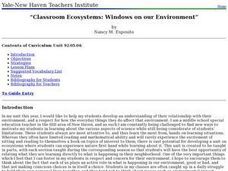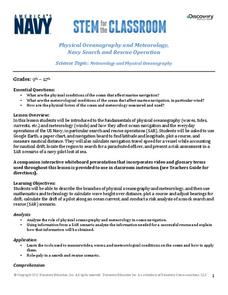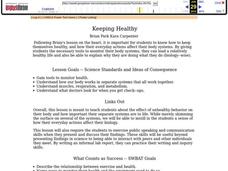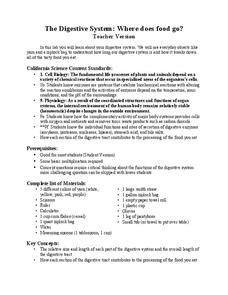Curated OER
Newton's Third Law
Students describe an everyday situation which demonstrates Newton's Third Law. They state Newton's Third Law;"Every action has an equal and opposite re-action, or every force has an equal and opposite force" in their own words. ...
Curated OER
Walking the Talk
Students research production, consumptions, and disposal of everyday items and their ecological impacts. In this sustainable economics lesson, students discuss clothing and various items used everyday in groups. Students then study a...
Curated OER
Thank You For the Food We Eat
Students explore where our food comes from. In this science lesson, students discuss how much of our food comes from animals. Students construct a mobile.
Curated OER
Birds of a Feather
Students investigate birds and complete a variety of bird-themed activities. They read books and observe birds noting their physical characteristics, development and life cycle stages.
Curated OER
Digital Picture Water Source Hunt
Students use a technological format to illustrate their understanding of the importance of water to life. For this water lesson, students read a picture a book and discuss the need for water. Students create a class chart about uses...
Curated OER
Build the Taiga: Hands on Biome-Building
Learners explore environmental awareness by completing a construction project. In this biomes lesson plan, students identify the different elements for life to thrive in an ecosystem. Learners utilize a cardboard or wood box to create a...
Institute of Electrical and Electronics Engineers
Sail Away
Students examine what naval architects and marine engineers do. In this engineering lesson students work in teams and design a boat with a sail structure.
Curated OER
Exploring Today's Technology
Second graders explore technology. In this science lesson, 2nd graders discuss various forms of technology. Students research technology that they use everyday and write a sentence about each one of the technologies.
Curated OER
Industry and the Environment
Students study industrial processes and greenhouse emissions. In this research lesson students choose a manufactured product, research the life cycle of the product, and present it in a PowerPoint presentation.
Curated OER
Classroom Ecosystems: Windows on our Environment
Students in a special education classroom examine their relationship with the environment. As a class, they examine the concept of a web of life and create their own classroom ecosystem. In groups, they record their observations and...
Curated OER
Build an Ice Cap
Students research Earth science by conducting an experiment in class. In this ice-cap lesson, students identify what an ice cap is and create a biome using a box which measures 1 ft. x 1 ft. Students participate in an animal role-playing...
Curated OER
Anatomy and Physiology
Students explore anatomy and physiology using various activities. In this biology lesson, students reasearch about medical radiation and its applications. They study cell cycle, cell division and other processes that sustain life.
Curated OER
In Their Own Words
High schoolers watch a video of people telling about their experiences with a mental illness. They compare and contrast the life stories they saw to reinforce how mental illnesses are biological illnesses that affect a person's thoughts,...
Teach Engineering
The Advantage of Machines
Show your students how to make their work easier. The first lesson in a series of 10 introduces the class to work and the way simple machines can be make work easier. The simple machines scholars can find in everyday items are...
Curated OER
Analyzing The Research Of The Earth
Students investigate the concept of technology. They are taught about various science applications and how the technology is used in the disciplines. Students pick a subject to research and then indicate the technologies related to it...
Curated OER
Chronology: They Time of My Life
Students demonstrate the importance of intact information to achieve accuracy. They compare and constrast their timelines with the chronological information contained in a stratified archaeological site.
Teach Engineering
Projectile Magic
What do the movies October Key and Harry Potter and the Sorcerer's Stone have in common? The fourth installment of a five-part module presents equations regarding projectile motion and how to rearrange them. Scholars view video clips...
Code.org
The Need for Encryption
Scholars investigate the need for encryption as they read a portion of the book Blown to Bits and discuss encryption techniques. They finish by attempting to decode a message written using a Caesar cipher.
Discovery Education
Physical Oceanography and Meteorology, Navy Search and Rescue Operation
It's an ocean rescue mission! Groups must find a pilot downed off the coast of the Chesapeake Bay. Rescuers must determine the distance needed to travel as well as the heading to get to the pilot's last known position. Taking...
Curated OER
Atoms and Elements: An Introduction
Students are able to discuss the difference between a proton, a neutron and an electron. They also can explain the difference between an ionic and a covalent bond. Students know the main structure of atoms and molecules. Student are able...
Cornell University
The Making of Macromolecules
Compare and contrast macromolecules made from the same elements. Young scholars learn how the structure of a molecule has as much influence on a compound as the elements in the molecule. They experiment with molecular model kits to...
Curated OER
Keeping Healthy
Learners describe the relationship between exercise and health. They name ways to monitor their health and the equipment used to do so. Students name solutions to common health issues and explain why good nutrition and exercise are...
Curated OER
Water Pressure Blaster
Third graders complete an experiment to introduce them to the concept of water pressure. In this water pressure lesson plan, 3rd graders create pressure in a water bottle and observe the force of water that is created.
LABScI
The Digestive System: Where Does Food Go?
Would you believe that your digestive system stretches to five times your height?! Help your pupils to understand this relationship as they work through the laboratory exercise. The first instructional activity of a 12-part series is a...























